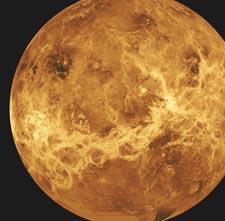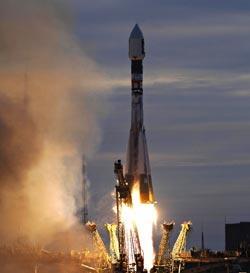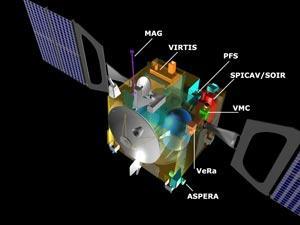Venus could be the ultimate example of what can happen when an atmospheric greenhouse effect runs away. A mission to the planet four billion years ago might have shed some light on what is happening on Earth. But Esa's Venus Express probe will instead foc
Venus could be the ultimate example of what can happen when an atmospheric greenhouse effect runs away. A mission to the planet four billion years ago might have shed some light on what is happening on Earth. But Esa’s Venus Express probe will instead focus on understanding the planet’s atmosphere, as Richard Corfield explains.
One of the most famous speeches in the history of space exploration was made at Rice University Stadium, Texas, US, on 12 September 1962. In it John F Kennedy set the agenda for the next decade of space exploration - committing the US to placing a man on the Moon by 1970. At the time Kennedy gave this speech a small and very primitive space probe was already speeding towards Venus. Despite its simplicity, this first probe to our nearest planetary neighbour had been dispatched to answer a crucial, nagging, question: was it the surface of the planet that was a prominent microwave emitter, or were the emissions coming from the swirling clouds that eternally veiled the face of the planet? This was important because if the answer was the former then no life could exist on Venus’ surface, if it was the latter, then.possibly.

The answer that the tiny probe returned was unequivocal. The surface of Venus was hot enough to melt lead. No life could possibly exist there. At the time it was enough to make the US lose interest in Venus as a potential extraterrestrial colony and yet today scientific interest in Venus is at an all time high.
Venus Express launches
A small European-built spacecraft is currently drawing close to the planet and will enter orbit on 11 April. Venus Express, the European Space Agency’s (Esa) first mission to Venus, set off from Baikonur Cosmodrome in Kazakhstan in November last year. It demonstrates the quiet revolution occurring in planetary exploration. The mission has been conceived and run by European scientists and launched atop a Russian rocket. It was only approved in March 2001 and yet it was launched less than five years later. Gone are the days of decadal turn-around times and billion dollar budgets.
But what is the attraction of Venus? It does not have the cachet of Mars where exploration has been driven by the search for water, and always - in the background - the possibility that the next mission to Mars will be the one that discovers evidence of life. Despite the loss of the Beagle 2 probe, Esa’s Mars Express mission was, and continues to be, a colossal success. Images continue to pour back from the Mars Express orbiter and it is now confirmed that not only did Mars once have liquid water on its surface, it almost certainly still has frozen water just below.

Venus has none of these romantic enticements despite being named after the goddess of love. In fact, with a surface temperature of 470?C, pressure of 90 atmospheres and an atmosphere composed of carbon dioxide laced with clouds of concentrated sulfuric acid, Venus has a good claim to be the most inhospitable of the inner, rocky planets.
But, if some of the press claims surrounding the Venus Express mission are to be believed, then the reason we are sending this probe is intimately linked to her inhospitable features: Venus, say some, is the ultimate example of what can happen when an atmospheric greenhouse effect runs away and going there will inform us about our own planet’s greenhouse effect. Venus is the bogeyman in the sky who warns us what the consequences of our own actions could be unless we take evasive action. To examine the accuracy of this statement we need to understand the background to Venus just a little better.
There was a time when Venus was considered to be a tropical Eden. Science-fiction stories of the early 20th-century portrayed it as a planet wallowing in a Carboniferous time-warp where towering cycads and tree ferns sheltered dragonflies whose wingspans were measured in metres. To top this vision of a Palaeozoic paradise, it was thought that Venus’ swamps would be populated by amphibian-like creatures busily making the same transition from water to land that we ourselves did about 400 million years ago during the Devonian and Carboniferous periods of Earth’s history.
By 1975 this myth had been dispelled. Ground-based spectroscopic observations had shown that not only were there no swamps on Venus but that the atmosphere was composed almost completely of carbon dioxide (with trace amounts of chlorine and fluorine). In addition the swirling cloud layers were made not of water vapour but sulfuric acid. The 1962 Mariner 2 probe had shown a surface broiling at the same temperature as a self-cleaning oven under pressures equivalent to those found beneath the Earth’s oceans.
Imaging attempts
For decades Venus’ atmosphere had thwarted any attempts to image the surface but the development of extra-terrestrial radar imaging changed that. In the 1960s ground-based radar probing from the Goldstone observatory in California’s Mojave desert, US, and the Arecibo observatory in Puerto Rico showed first that Venus’ orbit was retrograde (in the opposite direction to most other planets) and that the Venusian day is 243 Earth days long. By the 1970s refinements in radar imaging techniques began to show up some of Venus’ surface features including the bright (radar reflective highlands) known as Alpha Regio, Beta Regio and Maxwell Montes.
After the US’ Mariner 2 fly-by, Venus became the Russian planet. While the US turned its attention to the potentially more habitable Mars, it was left for the Russians to more or less single-handedly continue the exploration of Venus and through the late 1970s and early 1980s they barely missed a launch opportunity to explore the Venusian atmosphere and surface with their spectacularly successful Venera series of probes. In addition to Venera 9 - which sent back the first pictures from the surface of another world - Veneras 7, 8, 10, 11, 12, 13 and 14 all successfully soft-landed.
It is ironic that it was the tantalising glimpses of the surface of Venus sent back by the Venera probes that reignited US interest in Venus.
In 1978 the US was ready to return and dispatched the Pioneer Venus mission in 1978. The aim of the mission was two-fold. A cluster of four probes was designed to sample the atmosphere, while a radar-equipped orbiter probed beneath the veiling clouds for a closer look at Venus’ strange topography.
The images, despite being relatively low resolution, confirmed that Venus was a world vastly different from our own. There were small continental areas, vast plains and huge nurseries of active volcanoes. The evidence of active volcanism, coupled with the indisputable fact that Venus’ was so conspicuously acidic, led to one inescapable conclusion: the surface of Venus was geologically young and volcanically active. It was this that opened the debate on the nature of Venus’ strange atmosphere - had it always been like this or was the greenhouse in the sky new?
Raising questions
The success of the Pioneer Venus mission raised a series of questions that required follow up with still better eyes. Thus the Magellan mission of the late 1980s was born.
The questions that Magellan was tasked with answering were comprehensive and specific. Just what, exactly, is the nature of Venusian geology? Is Venus dominated by a plate tectonic regime similar to that of the Earth, or is it something completely different? What is the age of Venus’ surface? The face of the Earth is a composite hodge-podge of several billion years worth of varying forces, with rocks ranging from 3.8 billion years old to only a few thousand years old. Does the surface of Venus have a similarly varied age structure? Does erosion shape the surface of Venus in a similar manner to the way it does on Earth? But the main question that the Magellan scientists wanted answered was: had there ever been running water (the main agent of erosion on Earth) on the surface of Venus? It was a question that belied the biggest question of all: had the Venusian greenhouse effect always existed or had it developed over geological time, and if so, could it develop on other planets, such as our own?
With its high-resolution synthetic aperture radar, the results that Magellan sent back were nothing short of stunning and revealed for the first time just how alien our sister planet really is. The most surprising conclusion was one that must have gladdened the hearts of the Soviets for they had promoted the idea since the days of their own Venera probes. Venus has no plate tectonics, that is to say, there is no cycle of crustal creation in certain regions balanced by crustal consumption in other areas. The main geological force operating on Venus is volcanism.
Similarly, Magellan’s radar imaging showed that the density of craters across the face of Venus was such that the surface could not be more than 500 million years old - very recent in geological terms and contemporary with the rise of complex life in the oceans of our own planet. It appears that the lack of plate tectonics allows stresses and strains to build up in Venus’ crust that are relieved periodically and cataclysmically, rather than more or less continuously as on Earth. In fact the face of Venus was apparently resurfaced more or less instantaneously half a billion years ago.
Perhaps though the most significant result for the study of the Venusian greenhouse effects came from combining the erosion results with previous measurements of the ratio of deuterium to hydrogen in the Venusian atmosphere. Magellan found no evidence for erosion on the surface of Venus, thus confirming the lack of surface water. The D/H ratio results returned by the Pioneer Venus probe had earlier suggested that Venus had lost its isotopically light hydrogen (and therefore its water) early in its history and was now dominated by deuterium which, being heavier, was more easily retained by gravity. The conclusion was inescapable: Venus had once had water - perhaps even oceans and life - but now it was all gone and the agent for its removal had been Venus’ terrifyingly powerful greenhouse effect.
When and how Venus lost its water are two outstanding mysteries. Was it simply its closer proximity to the Sun that boiled off the ocean? And how long did this take after the formation of the planet 4.5 billion years ago? Whichever, the lack of water meant that a major CO2 sink available on earth - the oceans and therefore carbonate sediments - was denied Venus and CO2 accumulated in the atmosphere. As the seas boiled away they added water vapour (another potent greenhouse gas) to the atmosphere so plunging Venus into a positive-feedback greenhouse loop of unprecedented severity. After eons the isotopically light hydrogen in the water leached into space leaving only heavy deuterium - and a scorched Venus - behind.
Today, despite being closer to the Sun than us, Venus reflects more sunlight because of its bright clouds - clouds that may be the result of those long ago events. Therefore it is no longer exposure to the sun’s rays that is responsible for the present extreme heat of the planet, it is its greenhouse effect.
Return to the shrouded planet
All of which brings us back, a decade later, to the Venus Express mission where the emphasis is now firmly on understanding the atmosphere of this forbidding planet.
Hakan Svedhem, ESA project scientist, sees the mission much more as an investigation of the uniqueness of Venus rather than to compare it to Earth.

The seven instruments Venus Express carries will give us a comprehensive look. The emphasis will be on building up a three-dimensional picture of Venus’s thick, CO2-rich, sulfuric acid-laced atmosphere. Specific questions will focus on the causes of the super-fast rotation of the atmosphere, the reasons for the differentiation of the atmosphere into several cloud and haze layers at different altitudes, the processes that control the atmosphere’s chemical balance and those that govern the escape of atmospheric components into space.
The underlying philosophy of the Venus Express mission is to use different instruments to investigate the same phenomenon simultaneously, thus providing a series of interdependent checks. Thus atmospheric temperatures will be investigated using the PFS, VIRTIS, VeRa and SPICAV instruments; chemical composition will be investigated using VIRTIS, SPICAV and PFS; and the interaction of the atmosphere with the solar wind will be tracked by ASPERA, MAG and VeRa etc.
One instrument that the Venus Express orbiter is not carrying though is one that might answer the most interesting question of all - the possibility that there might be life yet on Venus, in its clouds.
Recent studies have shown that Earthly bacteria can live in a host of unlikely and inhospitable spots, including clouds. Louis Irwin of the University of Texas at El Paso, US, believes that if life evolved on Venus before its ocean boiled away then it may have moved into the Venusian atmosphere when the going got tough, where pressure and temperature conditions are no more arduous than in some areas on Earth. It may be that such Venusian microbes actively exploit the intense solar UV radiation that the planet receives, as David Grinspoon of the Southwest Research Institute at Boulder, Colorado, US, believes.
While Venus Express is not equipped for a life-search on Venus, it will be asking why so much UV is absorbed by Venus’ dense atmosphere, after all, the reason could be the presence of the biggest prize in comparative planetology - life itself.
In the longer term Nasa is looking into the possibility of sending a probe to Venus to search actively for life. Irwin believes that the optimum mission design would be a balloon-equipped spacecraft that would collect samples from the Venusian atmosphere during descent and then blast off from the surface to return them to Earth. Imagine the expression on the faces of those who study Mars if Venus, after all, is the planet with evidence of life.
But, will the Venus Express mission really contribute to our understanding of Earth’s greenhouse effect as some press reports would have us believe? It seems unlikely. The two planets are just too different now. Perhaps if the Venus Express probe had been launched when Venus was beginning to lose her water (about four billion years ago) the results would have been revealing. This highlights an important point about studying climate change on this, or indeed any, planet. For it to be truly useful somehow we must grasp a historical perspective of what happened and when. Only then can we hope to arrive at the how and why.
Understanding Venus’ greenhouse effect will probably have to wait until we have made real progress in unravelling its geological history, something that is well advanced here on Earth and which is just beginning to happen on Mars. Robot geologists such as Nasa’s Spirit and Opportunity rovers are now an integral part of Mars exploration. Such devices need to go to Venus too.
In the meantime it is enough to go to Venus and do basic research to pave the way for the robot - and maybe human - geologists of the future. As John F Kennedy said when he launched the Apollo programme at Rice University stadium in 1962: ’We choose to go to the Moon... we choose to go to the Moon in this decade. not because it is easy but because it is hard.’
Reason enough.
Richard Corfield is a freelance science writer
Instruments on board
ASPERA (analyser of space plasma and energetic atoms), developed by the Institute of Space Physics in Sweden, will study the interaction of the solar wind and the Venusian atmosphere.
MAG, the Venus Express magnetometer, developed by Austrian scientists, will measure the magnetic field around the planet that originates from the interaction of the solar wind with the atmosphere.

The Italian PFS, planetary Fourier spectrometer, will gather data on the vertical temperature structure of the atmosphere from the surface to its boundary with space and will help determine the composition of the atmosphere and aid in the search for volcanic activity.
The imaging SPICAV spectrometer (spectroscopy for investigation of characteristics of the atmosphere of Venus), developed by France and Russia, will look for traces of water vapour, molecular oxygen, and sulfur compounds.
The German VeRa (Venus radio science) experiment will use the radio communications between Venus Express and Earth to conduct radio sounding of the planet’s atmosphere, ionosphere, and the solar corona. Results will yield information about the density, temperature and pressure of the upper atmosphere.
The joint Italian-French visible and infrared thermal imaging spectrometer, VIRTIS, will use three observation channels to determine the composition and cloud structure of the lower atmosphere.
The German VMC (Venus monitoring camera) will capture images at visible, near-infrared, and ultraviolet wavelengths to study global cloud dynamics.






No comments yet